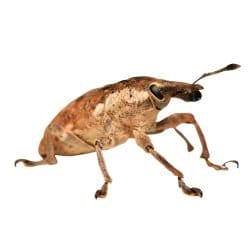Weevils

Identification
Some Weevils are brightly colored with intricate patterns, while others are plain black or brown.
Weevils come in various sizes, with some species measuring just a few millimeters in length while others can reach up to 6 mm.
Weevils are generally small and have a characteristic snout or rostrum that elongates into a slender feeding tube. The antennae and mouthparts are also located at the end of this snout. Another unique feature of weevil anatomy is their legs, which are often short and stout compared to other beetles. This allows them to navigate safely through dense vegetation without getting tangled up or caught by predators.
Get A Free Quote
We are affordable Pest Control Service in GTA & Surroundings Areas.
What are weevils, and what do they do?
Weevils can be found in various habitats and feed on different plants, including grains, nuts, fruits, and vegetables. Weevils have a distinctive elongated snout that they use to bore into plant material and lay their eggs inside.
The larvae of weevils feed on the plant material, causing damage to crops and stored food products. They also help in the decomposition process by breaking down organic matter. Weevils can affect different types of crops, such as rice, wheat, corn, beans, and peas, among others.
Distribution: Where do weevils live, and what do they eat?
Weevils are small beetles that are known to be pests in various industries, including agriculture and food production. They can cause significant damage to crops and stored food products. Weevils are found worldwide, particularly in warm and humid regions. They have many habitats, from woodlands and grasslands to agricultural fields.
Discover expert tips on safeguarding your home from weevils and Ticks, ensuring a pest-free and comfortable living environment and your crops.
Weevils can feed on a variety of plants, including fruits, vegetables, grains, nuts, and seeds. Some species focus on specific plants, while others have a broader diet. Adult weevils lay their eggs on the surface or inside the plant material they prefer to eat. Once hatched into larvae, they burrow into the plant matter, where they develop until adulthood. Weevil infestations can result in significant economic losses for farmers and food manufacturers, who may need to dispose of contaminated products or treat them with pesticides.
Life Cycle
Weevils are small, herbivorous beetles that can be found in a wide range of environments. Regarding their reproductive process, female weevils lay their eggs in cracks and crevices in their living environment. After a few days, the eggs hatch into larvae, then feed on nearby plant material.
Weevil larvae continue to feed for several weeks before pupating into adults. Once they emerge from their pupal stage, adult weevils mate and the cycle begins again. Depending on the specific weevil species, this life cycle can take a few weeks to several months.
However, it’s important to note that not all weevils will reproduce at the same rate or follow this same life cycle. Factors such as temperature, humidity levels and food availability can all impact how quickly these insects develop and reproduce.
Residential Pest Control Service
Customized pest control treatments can be used to safeguard your living space against bothersome pests and ensure that they don’t become a nuisance in your home.
Preventing Weevil Infestations
Weevils can easily find their way into your home through cracks in walls or floors. The first step in preventing weevil infestations is to ensure that all food items are properly sealed in airtight containers. This includes flour, cereal, rice, pasta, and any other dry goods.
Another effective method for preventing weevils is to freeze your dry goods before storing them. Freezing kills any eggs or larvae that may be present in the product before it’s stored. If you notice any signs of weevils or other pests, such as small holes or web-like material around your stored food items, it’s best to dispose of them immediately.
Lastly, keeping your home clean and clutter-free can also help prevent weevil infestations. Regularly vacuuming floors and wiping down surfaces where crumbs may accumulate will reduce the likelihood of attracting these pests into your home. By following these simple tips, you can help prevent weevils from damaging your stored foods and keep them out of your home.
